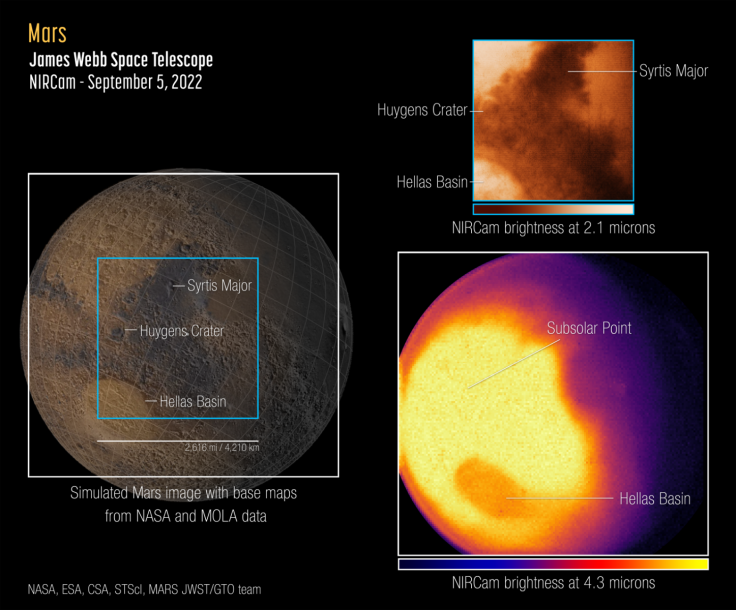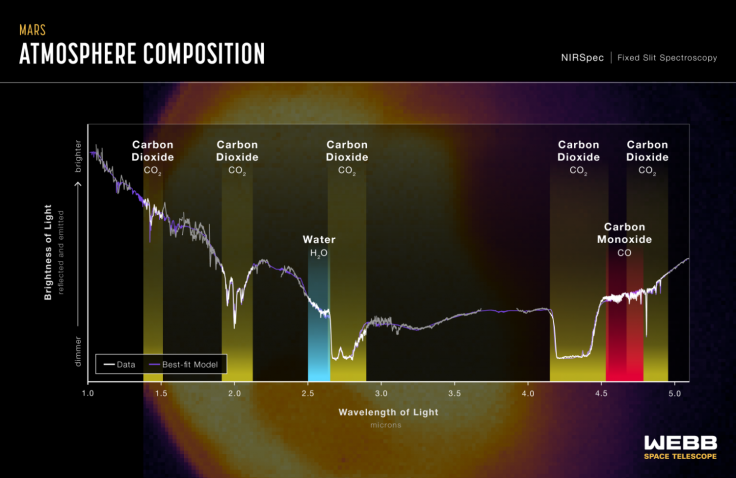
The first images of Mars taken by the James Webb Space Telescope (JWST) have been made public. On Sept. 5, JWST's position about 1.6 million kilometers from Mars allowed it to capture the images and take measurements.
At the Europlanet Science Congress (EPSC) 2022, the first Mars photos and spectra from JWST were presented on Sept. 19.
What Does JWST's First Images of Mars Revealed
JWST's Near-Infrared Camera (NIRCam) took pictures of Mars' observable disk, which is the side of the planet that faces the telescope and is illuminated by the sun.
Two different infrared wavelengths from JWST photos depict Mars' eastern hemisphere.
The image on the top right, which used shorter wavelength, revealed surface features often seen in visible-light images. It is a result of reflected sunlight.
The image at bottom right, which uses a longer wavelength reveals information about the concentrations of carbon dioxide in the Martian atmosphere. The image also shows the heat emitted from Mars's surface and atmosphere.
How Can JWST's Images of Mars Help Scientists
In addition to the investigations performed by rovers like NASA's Perseverance, these images may give planetary scientists a new perspective on Mars.
The JWST should allow the study of events in the Red Planet that occur over a short timescale since an entire face of Mars may be scanned at once in high resolution with a little exposure time. Thanks to JWST, scientists can study the dust storms and weather patterns of Mars easier.

JWST's mages will also make it easier for researchers to identify the source of any detected trace gases in the Red planet.
These small trace gases are present in the Martian atmosphere and are crucial for identifying possible biological or geological processes in the planet.
Earlier missions have detected trace gases in the Martian atmosphere using orbiters, which can only see a tiny portion of the planet at a time.
Challenges in Capturing Mars's Images
Capturing images of Mars is very challenging, even for the powerful observatory.
Mars is particularly challenging to photograph because, in contrast to most objects JWST generally observes, the planet moves quite fast through the solar system. In addition, JWST was built to identify very distant, faint objects, therefore it is pretty challenging to capture close planets like Mars.
"Now you can actually get these full images of the planet in the whole infrared range at incredible sensitivities," says Geronimo Villanueva at the NASA Goddard Space Flight Center in Maryland, according to NewScientist.
Another challenge scientists encountered when capturing images of Mars is its brightness.
"Mars is so bright, that the challenge is how to see it," said NASA Planetary Systems Laboratory at Goddard Space Flight Center scientist and lead investigator Giuliano Liuzzi, according to Space.com.
Scientists used extremely short exposures to study Mars in order to avoid blinding the JWST's equipment with its strong infrared light. In other words, just a portion of the light that reached JWST's detectors was only measured. Scientists then used some techniques to interpret the data gathered by the JWST.
Related Article : James Webb Space Telescope Snaps Stunning Photo of the Tarantula Nebula









